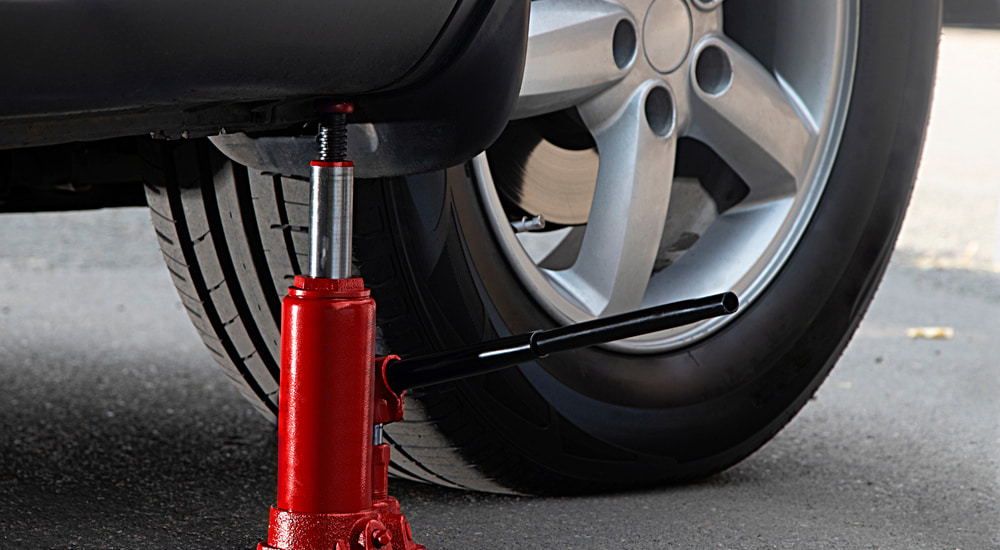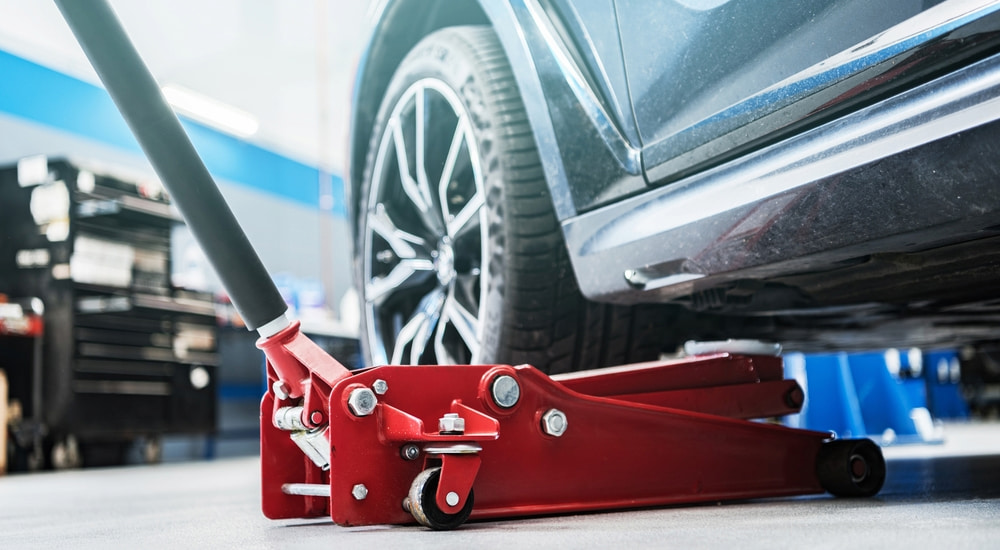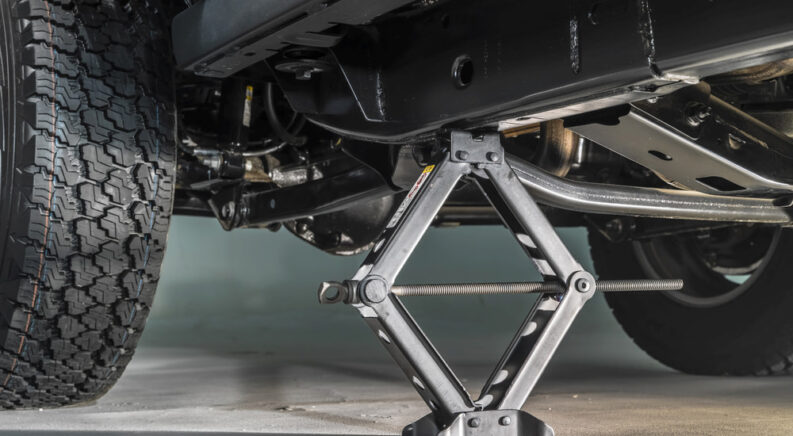From changing your oil, coolant, and tires to working on your exhaust system or swapping out your brake pads and rotors, many of the most common DIY projects require the use of a car jack and jack stands. While many drivers are familiar with these vital pieces of automotive equipment, they don’t exactly qualify as common knowledge. A 2016 survey by CheapCarInsurance.net found that over 20 percent of US drivers said they’re “clueless” when it comes to changing a tire, with an additional 20 percent pegging their skill level as “not very confident”.
Changing a tire involves more than simply jacking up a car, but this task can be a significant hurdle for some drivers. There’s always going to be something slightly intimidating about relying on a few inconspicuous hunks of metal to protect you from the weight of a two-ton vehicle, but, a jack and jack stands really aren’t all that tricky once you know what you’re doing. We’ve compiled a quick guide to jacks and jack stands to demystify the process, allowing readers to master this essential skill and open the door to a host of money-saving routine maintenance and repair tasks.
Choosing the Right Jack
When choosing a jack, consider three factors: weight capacity, clearance, and reach. Weight capacity is fairly obvious and describes how much poundage a jack can accommodate. A two-ton (4,000-lb) jack is fine for most projects, though the general rule of thumb is that a jack should be able to handle 75 percent of a vehicle’s total weight. Common jack stands range in capacity from two to six tons, but they do tend to get pricier as the capacity increases.
Clearance is the height of the jack. The average vehicle has at least five inches of ground clearance, but on low-profile vehicles like sports and performance vehicles or those modded with low side skirts, you need to ensure enough room to slip the jack underneath the car. Then there’s reach, which is how high a jack can safely extend. If you have a tall truck or SUV, you may need a jack with more reach just to get the wheels off the ground. Most commercial jacks have between six and 18 inches of lift, so read the fine print before hitting the checkout line.
Types of Jacks
While there are countless variations on the typical jack, most are reserved for specific applications. High-lift jacks, pneumatic jacks, and exhaust air jacks are just a few examples, although most drivers can get away with limiting their knowledge to three main types: scissor jacks, bottle jacks, and floor or trolley jacks. Let’s take a closer look at each of these jacks, examine their pros and cons, and determine which is the right choice for your vehicle.
Scissor Jacks
Scissor jacks are the most common type of car jack because they’re included in many new vehicles. They are typically located next to the spare tire in the trunk of a car or SUV or behind the first row of seating in a pickup truck. This jack, which takes its name from its scissor-like shape, is typically the lightest-duty version you can get away with. All scissor jacks are at least rated to lift the vehicle in which they’re included. These jacks work by inserting a rod into a long screw that runs through the jack, with each rotation bringing the jack a little closer to its maximum height.
The main advantage of scissor jacks comes down to their price and convenience. They’re available for as little as $20 to $30 and easily stashed in a trunk or under a seat, but they might not be right for every application. Scissor jacks are really intended for emergency situations like roadside tire changes and should not be your go-to choice if you see a lot of DIY projects in your future. This largely comes down to the fact that scissor jacks are a lot less stable than some of the other options on the market. This lack of stability might not make a huge difference when it comes to changing a tire, but if you’re going to be working under a vehicle for an extended period of time, it can be an important consideration. They can also be a little frustrating to use since the relatively simple jack requires a lot of elbow grease to crank to the needed height.
Bottle Jack
Named for its bottle-like shape, a bottle jack replaces the scissor jack’s mechanical approach with the power of hydraulics. Just place the bottle jack at the appropriate jacking point, attach the collapsible handle to the jack’s base, and you’ll be able to lift your vehicle easily with a simple pumping motion.
A bottle jack represents an important step up over a scissor jack in two important ways. It boasts a higher capacity than the typical scissor jack (or even similarly priced floor jacks) and is much easier to use. Bottle jacks are also inexpensive at $15 to $30. They are often smaller than scissor jacks, which makes them a good replacement for those looking to upgrade their vehicle’s emergency repair kit without sacrificing space. Like a scissor jack, the most significant disadvantage of a bottle jack is its lack of stability. While it might work fine on a flat, solid surface like a garage floor or driveway, it can be dangerously prone to tipping when deployed on loose gravel or soft ground. Bottle jacks also lack the lifting height of scissor and floor jacks, which might make them impractical when jacking up higher-riding vehicles like trucks and SUVs.
Floor Jacks and Trolley Jacks
If you’re in the market for a robust jack and aren’t afraid to make a bit of an investment, a floor or trolley jack is the way to go. A floor jack is built with wheels and a long, solid handle, so it’s easy to quickly slide under a vehicle for quick lifting and underbody access. Used by mechanics and automotive professionals worldwide, floor jacks aren’t cheap at between $100 and $300, but they excel when it comes to lifting heavy loads and keeping them stable. This improved capacity and stability does mean sacrificing portability, which is why floor jacks are often confined to garages, driveways, and other such workspaces.
A trolley jack is a heavy-duty version of a floor jack built with sturdier materials. This does mean it tends to be heavier and a little less portable. A trolley jack can also achieve a higher lift compared to a floor jack and is hard to beat when it comes to pure speed. Many trolley jacks are designed with a quick-release spring that allows a vehicle to be quickly lowered when the maintenance or repair task is complete, which can be an especially important consideration when it comes to labor costs.

Types of Jack Stands
Car jacks might offer varying levels of performance and stability, but no matter which type you choose, it’s important to remember that every jack should be supplemented by a sturdy set of jack stands. These are a critical piece of safety equipment anytime you’re jacking up a car, truck, or SUV, and should never be treated as an afterthought. Jack stands are solid pieces of heavy steel, cast iron, or aluminum built to support the vehicle’s entire weight instead of relying on the jack alone. Simply jack up a vehicle to the desired height, place the jack stands on the reinforced points (also known as “pinch welds”) on the frame, and then use the jack to lower the vehicle onto the stands. Jack stands typically come in three styles, which we’ll outline below.
Ratchet
Most jack stands you encounter will be the ratchet type. As the name implies, these jack stands rely on a ratcheting mechanism to hold the center column in place. Once the jack stand has been set to the ideal height, drivers can use a locking lever to keep everything secure. When you’re done with your project, simply jack up the car, release the jack stand lever, lower the stand, and you’re good to go.
Pin
A pin-type jack stand might look similar to the ratchet style, but instead of a ratcheting mechanism it relies on a steel pin to safely lock the column in place. Some premium jack stands even feature both a ratcheting action and an added safety pin. While ratchet and pin jack stands are fairly comparable, some prefer the extra adjustability of the ratchet design.
Screw
Finally, there are screw jack stands. These are a bit of an outdated design in this day and age, but they’ll work fine for most applications. Screw jack stands are just what they sound like, a giant screw set into a sturdy base that can be raised or lowered by turning the screw itself. The main disadvantage of a screw jack stand comes down to how long it can take to adjust it to the proper height. However, it’s also less prone to failure than the other types listed above.
Ramps
Jack and jack stands are a must-have for any well-stocked garage, but they’re not the only option for getting your vehicle off the ground. Ramps serve a similar purpose, allowing a driver to drive up onto a steel or polymer incline to gain a little lift without using a jack or jack stands. They are quicker than jacks, can often provide more lift, and don’t require jack stands, making them ideal for jobs like oil or fluid changes. That said, they do have their limitations. It can take a while to get used to navigating your vehicle up the ramps, especially if you don’t have an extra set of eyes to help out. They also take up a lot of storage space and aren’t ideal for low-riding vehicles. If your particular repair or maintenance task involves removing the wheels, they’re an obvious non-starter.

Wheel Chocks
While this article mostly focuses on jacks and jack stands, we need to discuss wheel chocks briefly. While these pieces of plastic, wood, rubber, or steel are relatively simple compared to jacks and jack stands, they serve an incredibly important role whenever your vehicle is lifted off the ground. Wheel chocks prevent accidental wheel and vehicle movement by keeping the tires firmly in place, helping drivers avoid some of the worst outcomes imaginable. This is why placing and removing them should be the first and last steps in any lifting process.
While we’ve covered the basics that should help you pick out your own set, we want to mention a few important safety tips before we close out. First, remember only to use a jack and jack stands on level, firm ground. This might be tricky if you’re stranded on the side of the highway, but in some cases, driving just a little further to a rest stop might actually be the safer option. Second, familiarize yourself with your vehicle’s jacking points, as placing a jack at the wrong point can potentially lead to long-term damage. Always engage your emergency brake when using a jack, and never crawl under the vehicle when it’s only supported by the jack. Rather, lower the vehicle onto the jack stands as soon as possible so the jack isn’t left to do all the heavy lifting.
Jacks, jack stands, and ramps are an important part of any at-home mechanic’s arsenal. Follow these tips, and you’ll be able to tackle a long list of automotive tasks from the comfort of your own garage.

